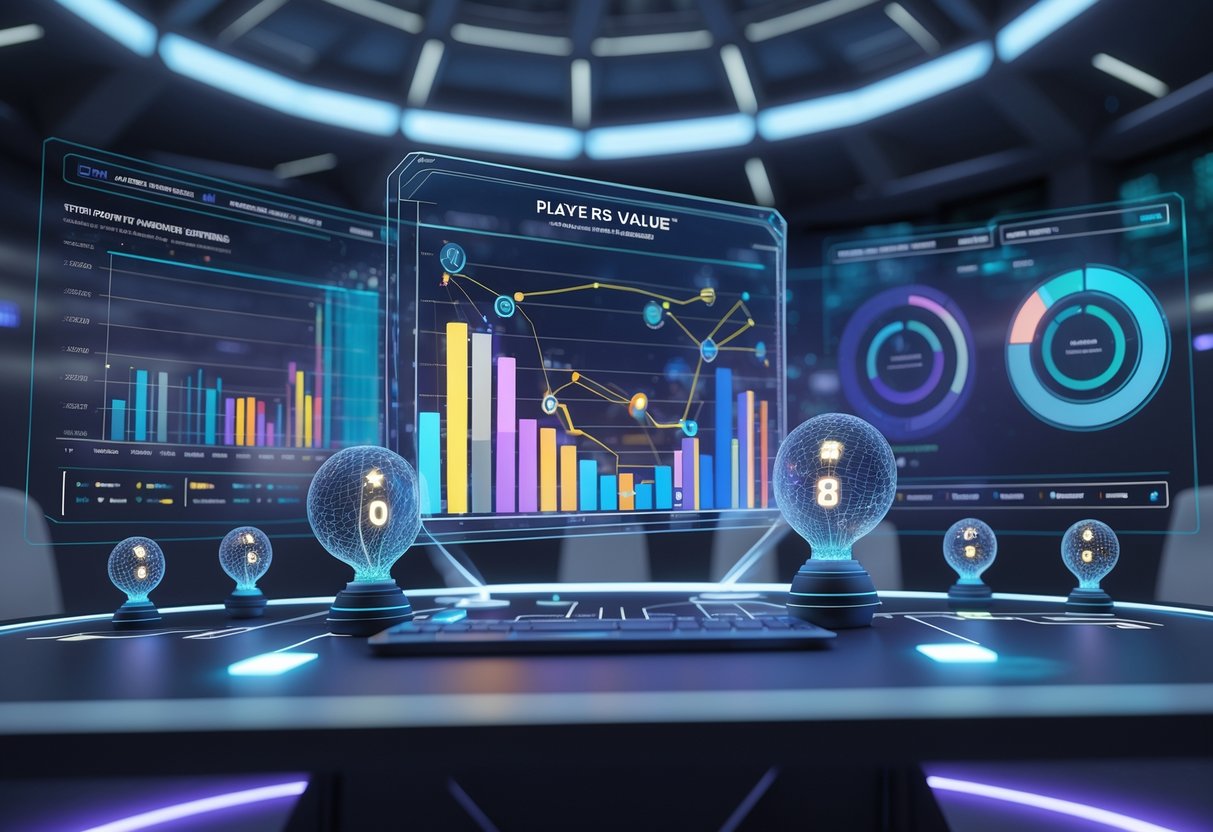Dynasty Team Analysis: Expert Tools, Tactics & Insights
Updated On: October 26, 2025 by Aaron Connolly
Understanding Dynasty Team Analysis
Dynasty team analysis isn’t like your typical fantasy formats. We have to look at both short-term performance and long-term upside, all while keeping player development and career paths in mind.
Purpose and Importance
Dynasty team analysis acts as your blueprint for building a roster that can actually win championships. Unlike other fantasy leagues, our choices stick around and shape our teams for years, sometimes even a decade.
We’re trying to figure out if our roster can compete right now or if we need to hit the reset button. That decision impacts every trade, waiver claim, and draft pick.
Key things to check:
- How your roster stacks up against the rest of the league
- The age of your starters
- Depth at each position
- What kind of draft picks you’ve got in the bank
Dynasty analysis lets us spot value too. Sometimes you’ll find a young receiver who’s struggling but could be a steal if his manager wants instant results.
We use this info to make smarter moves. Quick win: Try tools like Dynasty Daddy or KeepTradeCut to get a feel for player values before you make a trade.
It also helps us avoid big mistakes. If you trade away all your young talent for old vets, maybe you win now—but you’ll pay for it later.
Key Differences from Redraft and Keeper Leagues
Dynasty analysis digs way deeper than redraft. In redraft, we just care about this season. Dynasty? We’re projecting value three to five years out.
Position aging really matters:
- Running backs usually peak in years 2-3, then drop off fast
- Wide receivers might break out later but stay good longer
- Quarterbacks can stay elite for a decade or more
Redraft is all about weekly matchups and hot streaks. Dynasty makes us weigh those against how we’re building for the future.
Keeper leagues are a middle ground. Maybe you keep five players, but in dynasty you might keep 20 or more year after year.
Trades feel totally different. In redraft, you might swap similar players for a bye week fix. In dynasty, you’re often giving up today’s points for tomorrow’s stars.
Draft picks mean more in dynasty. That rookie who’s not doing much now could be a stud by year three.
Long-Term Strategic Goals
Winning in dynasty means juggling a bunch of priorities. We want to win titles, but we also want to keep our options open for the future.
Championship windows set the tone. If your main guys are 24-28, you’re in that sweet spot. Trade some picks for upgrades and go for it.
If you’re rebuilding, chase young players with upside. Sometimes you just have to accept a rough year to build a real contender.
Managing assets is everything:
- Draft picks are trade chips
- Unproven young players still have value
- Sell off aging vets before they tank
Don’t forget about succession planning. If your QB is 32, you should probably start looking for his replacement before you’re desperate.
Heads up: Try not to get stuck in the middle. Teams that aren’t really contending or rebuilding just spin their wheels and waste resources.
We’re not here for one trophy and done. The real challenge is building a squad that can chase titles for years.
League Settings and Format Impact
League settings in dynasty fantasy football totally change player values and how you build your team. If you don’t get how scoring, roster construction, or playoff formats affect your dynasty team analysis, you’ll make bad calls.
Custom Scoring Systems
PPR scoring flips dynasty analysis on its head compared to standard scoring. Suddenly, wideouts who rack up catches but not yards become more valuable.
Running backs who can’t catch? Their value drops off hard. In half-PPR, pass-catching still matters a lot, but it’s not as wild.
PPR changes things:
- Slot receivers get a 20-30% value bump
- Third-down backs can actually start for you
- TEs with big target shares shoot up the rankings
- Deep threats lose some shine
Tiered PPR adds more wrinkles. If you get more points for long catches, those deep threats jump back up.
Touchdown-heavy scoring (6 points for all TDs) boosts red zone guys. Goal-line backs and end zone targets become way more valuable.
Roster Construction Rules
Dynasty rosters with 25-30 players make depth guys a lot more important. Bigger benches mean you can stash future talent and trade more creatively.
Starting lineup rules change everything. If you only have six skill spots, you need superstars. If you’ve got 8-9 flex spots, depth wins out over big names.
Most dynasty starting lineups look like:
- 1 QB, 2 RB, 2 WR, 1 TE
- 3-4 flex (RB/WR/TE)
- Forget kickers and defenses
If you need to start more players, rebuilding teams can trade depth for picks. Contenders need more bodies, which raises the price for solid role players.
Bench size really shapes waiver strategy. Small benches mean you’ll see more streaming, but you can’t hoard as many prospects.
Playoff Structures
Six-team playoffs in a 12-team league hit a nice balance. If too many teams make it, the regular season feels pointless.
The two-win system gives a win for head-to-head and another for finishing top-half in weekly points. This setup cuts down on luck and rewards deep, steady rosters.
Why two-win works:
- Best teams make playoffs more often
- Schedules matter less
- Depth pays off
Week 17 championships mean you avoid the mess of Week 18 benchings. Most leagues now wrap up before the NFL’s last week to keep things fair.
Playoff byes for top seeds add real value to regular season wins. That pushes contenders to make bold moves.
Longer regular seasons shift the trade deadline and make you value steady producers over boom-or-bust types.
Initial Team Assessment Techniques
Good dynasty team evaluation starts with knowing what your roster is really worth and figuring out where you stand. Don’t just look at your record—think about long-term potential and if you’ve got enough depth.
Evaluating Overall Team Value
Start by figuring out your entire roster valuation. It’s not just about your starting lineup.
Dynasty team analyzer tools can give you a ballpark for your total value. They’ll compare your players to current market prices and dynasty rankings.
Metrics to watch:
- Total value compared to league average
- Age-weighted value (younger is better)
- Adjust for position scarcity
- Include your future draft picks
Your roster’s age matters a ton. A squad worth £1,000 with 24-year-olds is way better than the same value in 29-year-olds.
Don’t forget about your picks. Early picks in a good draft class can out-value aging stars.
Tip: Don’t let sunk costs trap you. If you paid a premium for a vet last year, but he doesn’t fit your timeline now, move on.
Analysing Positional Strengths and Weaknesses
Every dynasty roster has gaps somewhere. You need to know where you’re stacked and where you’re thin.
Build a depth chart. Count how many startable options you’ve got at QB, RB, WR, and TE.
Most leagues start 1 QB, 2 RBs, 2-3 WRs, and 1 TE. You’ll want more than just the starters for byes and injuries.
What to aim for:
- QB: 2-3 rostered (one starter, one or two backups)
- RB: 4-6 rostered (injuries happen)
- WR: 6-8 rostered (they’re usually more stable)
- TE: 2-3 rostered (unless you have a stud)
Watch those age cliffs. RBs start fading after 28. WRs last longer. TEs peak late but drop fast.
Quick win: Check weekly points lost by position versus the league average to spot weak spots.
Deciding Between Competing, Contending, and Rebuilding
This call shapes every move you make. Be honest about your championship window.
Competing teams have a top-3 roster and prime-age stars. Trade picks for upgrades and chase the title.
Contending teams can make playoffs but need a piece or two. Make smart trades, but don’t sell out your future.
Rebuilding teams aren’t close. Trade old vets for youth and picks.
Records can mislead you. A 2-4 team with bad luck and young talent might be better set up than a 4-2 team full of aging vets.
Consider your league’s skill level. In tough leagues, you need stars to win. In casual leagues, depth can be enough.
Ask yourself:
- Do you have at least 6-7 strong starters?
- Are your best players under 27, or are they pushing 30?
- How many teams are clearly better than you?
Most managers try to win too soon. Sometimes, it’s better to rebuild right than to keep finishing in the middle.
Leveraging Dynasty Team Analyser Tools
Modern dynasty team analyser platforms now sync with your leagues and offer insights that really change how you manage your roster. You’ll get weekly projections and lineup advice tuned to your league’s rules and your specific squad.
Platform Integration and League Sync
Most dynasty analysers plug right into the big fantasy sites like Sleeper, ESPN, and Yahoo. You just enter your league ID or authorize access, and your roster gets pulled in automatically.
To find your league ID:
- Sleeper mobile: It’s at the bottom of “General Settings”
- Sleeper web: Check the URL after “/leagues/”
- Other sites: Usually in settings or the browser bar
Once you’re synced, the tool grabs your roster, league settings, and even trade history. No more manual data entry.
The best ones update several times a day. If you run multiple teams, they’ll track all your players across every league.
Heads up: Some features need a paid subscription, usually £10-30 a year.
Personalised Lineup Recommendations
Dynasty analysers break down your roster and suggest your best weekly lineup. They factor in matchups, injuries, and usage trends, all based on your league’s scoring.
You’ll usually see:
- Start/sit calls for tough lineup choices
- Matchup analysis against opposing defenses
- Snap count trends so you see who’s getting work
- Target share data for WRs and TEs
They’ll even rate each recommendation for confidence. You’ll see risky plays flagged and possible breakout bench guys highlighted.
Quick win: Pay attention to 80%+ confidence picks, especially for flex spots where it really matters.
Customised Weekly Player Projections
Weekly projections from dynasty analysers use your league’s actual scoring. Generic projections might miss your bonus points or flex rules.
These projections adjust for:
| Projection Element | How It’s Customised |
|---|---|
| Scoring system | PPR, half-PPR, or standard |
| Bonus points | Yardage milestones, long TDs |
| Roster limits | Flex positions, superflex |
| Matchup difficulty | Recent defensive performance |
The top tools blend several projection sources and weight them by past accuracy. They’ll tweak for weather, rest days, and even coaching trends.
Weekly projections help you spot:
- Undervalued starters
- Trade targets underperforming
- Waiver wire gems with good matchups
Some platforms even email you a weekly summary showing where you’ve got the edge—or where you’re in trouble—compared to your opponent.
Power Rankings and Comparative Analysis

Trying to figure out how your dynasty team stacks up against the rest? That’s what power rankings are for. Most modern rankings use real-time player values and consensus data to sort every roster in your league from strongest to weakest.
League-Wide Team Rankings
Power rankings turn complicated roster data into easy-to-read league standings.
They add up the value of every player and draft pick on your roster to give you a snapshot.
With these rankings, you can see:
- Which teams have the most valuable rosters right now
- Who’s set up for long-term success versus short-term wins
- Where trade opportunities might pop up
Most tools update these rankings daily as player values shift.
You might see your team drop from 3rd to 5th after a key injury, or climb up if one of your players suddenly breaks out.
The best systems adjust for your league’s settings.
Superflex leagues value quarterbacks way differently than standard formats.
Points per reception (PPR) leagues boost running backs and wide receivers who catch a lot of passes.
Quick win: When you hit the top spot, screenshot your power ranking and share it with your league mates. Why not brag a little?
Interpreting Dynasty Power Rankings
Raw rankings only tell part of the story.
You’ve got to dig deeper to figure out what those numbers mean for your team’s future.
Check out roster construction along with your overall ranking.
A 6th-ranked team full of young talent might actually have a brighter future than a 2nd-ranked squad loaded with aging vets.
Keep an eye on:
- Age distribution across your roster
- Upcoming contract situations in salary cap leagues
- Draft pick assets for the next few years
Position group breakdowns help you spot strengths and weaknesses.
Maybe you’re 4th overall but only 10th in running back depth—that’s your cue to look for a trade.
Many tools also show projected rankings for future seasons.
This helps you decide if you should go for it now or start rebuilding for later.
Identifying Tier Breaks
Tier breaks split teams into clear groups, not just a smooth ranking list.
The gap between 3rd and 4th could be huge, while teams ranked 7th through 10th might be almost identical.
Contender tier: Usually the top 2-4 teams. They’ve got the talent and depth to win it all.
Competitive tier: Teams 5-8 that could make playoffs but need a bit of luck or a smart move.
Rebuilding tier: Bottom teams focusing on youth and future draft picks.
Middle tier: The trickiest group. These teams aren’t bad enough to tank but not strong enough to compete. They face tough choices about buying or selling.
Understanding tiers can help you a lot with trade negotiations.
Teams just outside the contender tier might overpay for the last piece they need.
Rebuilding teams will chase future assets instead of win-now players.
Heads up: Don’t stress over small ranking changes. Focus on tier movement instead of obsessing about moving from 6th to 4th.
Player Value Dynamics in Dynasty

Player values in dynasty leagues are always changing.
Age curves, projection timelines, and player archetypes all play a role in how we should look at long-term value.
Short-Term vs Long-Term Projections
Dynasty managers have to juggle immediate production with future upside.
A 30-year-old running back might crush it this season but could be useless two years from now.
Short-term value drivers include current team situation, injuries, and opportunity.
These create quick value spikes that savvy managers can use in trades.
Long-term projections care more about sustainable skills and where a player’s career is headed.
Wide receivers usually hold their value longer than running backs because they take less of a beating.
Key timeframes to think about:
- Next 12 months: Focus on current lineup and injury risk
- 2-3 years: Peak window for most positions
- 4+ years: True dynasty assets with staying power
You should weigh these timeframes based on whether you’re rebuilding or making a run at the title.
Rebuilding teams chase long-term upside, but contenders need instant impact.
Weight-Adjusted Age and Age Curves
Age is just one part of dynasty valuation.
Position-specific aging and usage history matter just as much.
Running backs usually peak around ages 24-26, then drop off fast.
A heavy workload speeds up that decline, no matter how old the player is.
Position aging patterns:
- Quarterbacks: Peak 28-32, hold value into their mid-30s
- Running backs: Peak 24-26, sharp drop after 28
- Wide receivers: Peak 26-29, slow decline into early 30s
- Tight ends: Peak 27-30, but this varies a lot
College production age is a big deal for rookies.
Older prospects who dominated in college may not last as long in the NFL as younger breakout stars.
Usage rates really matter, too.
A 25-year-old running back with 800 career touches is much riskier than a 27-year-old with only 400.
Player Archetypes and Profile Analysis
Different player types age and develop at wildly different rates.
Physical freaks often peak early, while technical players can hang around longer.
Wide receiver archetypes:
- Size/contested catch guys: Longer careers, steady targets
- Speedsters: Peak early, get hurt more
- Route runners: Age well, stay efficient
Running back types show even sharper differences.
Power backs usually last longer than speed backs, but both can hit the wall fast.
Quarterback mobility changes aging curves a lot.
Dual-threat QBs might lose rushing upside but keep passing value, which makes their dynasty value tricky.
Development timelines:
- Raw athletes: Higher ceilings, need more time
- Polished prospects: Produce early, but sometimes with a lower ceiling
- Character flags: Volatile value, risk of off-field issues
You’ve got to match player profiles to your team’s timeline and risk appetite when making dynasty moves.
Strategic Trading and Trade Evaluation

Smart trading is the heart of dynasty.
Modern tools help us evaluate offers and spot the best trade partners.
Using Dynasty Trade Calculators
Dynasty trade calculators take the emotion out of trading.
They use expert rankings and scoring systems to show if a deal is fair.
DynastyProcess gives you the most customizable calculator out there.
You can tweak settings for superflex, rookie picks, league depth, and your scoring system.
Key features to use:
- Startup vs established league modes
- Rookie pick optimism
- Positional scarcity tweaks
- Multi-year projections
Most calculators show the percentage difference between trade sides.
A 10-15% gap usually means it’s fair.
If you see a 20%+ difference, you’re probably giving up too much.
Run your ideas through a few calculators.
FantasyPros Dynasty Ranks power a lot of tools, but comparing results can help you spot weird outliers.
Assessing Trade Value Charts
Value charts help you figure out what players are worth compared to draft picks and other assets.
These charts shift all season as players perform and injuries happen.
Early season values lean on preseason rankings.
Mid-season charts look at real production and strength of schedule.
You need updated charts to make good calls.
Draft pick values move around a lot:
- Early 1sts are gold
- Mid-to-late 1sts = solid veterans
- 2nds are in the breakout lottery range
- 3rd+ picks rarely match proven players
Don’t trust old value charts.
August rankings are basically useless by October with all the injuries and surprises.
Rookie picks get more valuable as the draft approaches.
That late 1st might equal a fading vet in September, but by March, everyone wants the young starter.
Trade Partner Finder and Offer Builder
Finding good trade partners means you need to know each team’s roster construction.
Look for teams with needs or extra assets that line up with yours.
Contenders want proven vets.
They’ll pay up for instant impact, especially at key spots.
Target these teams when you’re selling aging players.
Rebuilders are after youth and picks.
They’ll take on riskier prospects if the ceiling is high.
These teams are where you can move your developmental pieces.
Modern dynasty tools like DynastyGM let you analyze league rosters fast.
You can spot teams with obvious holes or extra assets without digging through every roster.
Building good offers starts with understanding what the other team wants:
- What positions do they need?
- Are they competing or rebuilding?
- Who might they actually move?
- What’s their draft pick stash look like?
Always send a couple of variations.
If your first offer gets shot down, having a backup keeps things moving instead of stalling out.
Draft and Rookie Pick Insights

Learning how to maximize value in both startup and rookie drafts is key to dynasty success.
Smart draft positioning and pick valuation can set you up for years.
Dynasty Startup Draft Strategies
Early rounds are for proven veterans with 2-3 years of elite production left.
Target players aged 24-28 who’ll help now and hold trade value.
Middle rounds are where you find upside.
This is your chance to grab breakout candidates and older players at a discount.
Don’t ignore talent just because of age—a 29-year-old WR in a good offense can outscore a 23-year-old on a bad team.
Late rounds are all about calculated risks.
Snag handcuffs and high-upside rookies.
Don’t get caught chasing big names—prioritize opportunity.
Positional strategy matters.
If you’re in Superflex, grab QBs early since they score big and last longer.
In standard leagues, you can wait on QB and stack skill players.
Some draft day tips:
- Trade back often—early picks get overhyped by rookie fever
- Target steady producers in rounds 3-8
- Avoid injury-prone vets unless they’re a screaming value
Maximising Rookie Draft Value
Pre-draft prep wins leagues.
Check landing spots, depth charts, and coaching tendencies before your rookie draft kicks off.
Players like TreVeyon Henderson are steals if they fall to picks 1.05-1.06.
He’s got elite college production but gets overlooked in loaded classes.
Round 2 is where you find hidden gems.
Tre Harris, now with the Chargers, could see immediate opportunity opposite Ladd McConkey.
His 1,030 yards and sticky hands make him a smart pick around 2.06.
Third-round athletes sometimes surprise everyone.
Jayden Blue brings 4.38 speed to a Dallas backfield that’s wide open—perfect for a breakout.
Positional scarcity should guide your picks:
- RBs hit their peak early but fade fast
- WRs take longer to develop but stick around longer
- TEs often don’t break out until year 2 or 3
- QBs in Superflex are worth premium picks
Trading tips:
- Trade up for your favorites—don’t count on them falling
- Trade down to rack up picks—more shots often beats swinging for just one guy in rookie drafts
Future Pick Valuation
Next year’s picks usually trade at big discounts. You might see a 2026 first-rounder go for what looks like an early 2025 second.
Pick trading windows really matter. Future picks hit their highest value during your rookie draft—everyone gets hyped. Sell then if you can. Buy during the season, when managers want instant help.
Draft pick values shift for a few reasons:
- Teams that are tanking end up with more valuable picks.
- A strong draft class (like 2025’s loaded RB group) bumps up pick prices.
- Superflex leagues boost pick values by 20-30%.
Try these smart valuation moves:
- Project team records early. Buy picks from playoff teams, sell to rebuilders.
- Keep tabs on college prospects all season.
- Trade picks before your draft, while hype is peaking.
Watch out for common mistakes:
- Overrating your own team’s future picks.
- Forgetting how fast situations change.
- Ignoring pick timing—early picks are way more valuable.
If you want a quick edge, track college standouts as the season rolls on. Spotting next year’s studs early can give you a massive trading advantage.
Waiver Wire and In-Season Management

Winning the dynasty waiver wire game means paying attention all season. We have to juggle immediate needs with future potential, and keep churning the roster for value.
Identifying Key Waiver Wire Targets
We shouldn’t just chase youth blindly. Instead, let’s target players who fit certain situations. The best waiver wire adds usually fall into four main buckets.
Veteran free agents can be sneaky valuable. Guys like Ryan Tannehill or Mike Gesicki might look washed, but NFL teams crave experience. When they land on a new roster, their trade value can jump overnight.
Former high draft picks still carry name value. Clyde Edwards-Helaire and Rashaad Penny have let managers down, but people remember the hype. If they get a fresh start, you can flip them for a profit.
Situational breakout candidates pop up when injuries or bad performances open doors. We should look for handcuff running backs, third receivers on explosive offenses, and backup QBs in good systems.
Contract year players often get more work as teams figure out their future. Sometimes, these guys explode down the stretch, turning into nice trade chips for next year.
Continuous Roster Churn
Dynasty success demands constant roster turnover at the bottom of the bench. We need to drop and add every week, always searching for upgrades.
Every week, evaluate your bench. Did someone’s target share jump? Did an injury ahead of them create a shot? Are beat reporters buzzing about them? Small stuff often hints at bigger things to come.
Track minor injuries too. Backup players can get more practice reps, and sometimes that leads to real chances.
Beat reporters often drop hints about player roles and coaching favorites. Local coverage sometimes spots changes before they show up on Sundays.
We shouldn’t get stuck holding underperformers. Quick drops and bold adds usually beat loyalty to disappointing players.
Balancing Short- and Long-Term Adds
Our waiver strategy has to serve both today’s needs and tomorrow’s plans. Striking this balance is what keeps a dynasty team humming year after year.
Contenders should focus on players who can help right now. Handcuffs, bye-week fill-ins, and proven vets matter more than long shots during a playoff run.
Rebuilders should chase future value, not current points. Look for players who might step into better roles next year, restricted free agents, or anyone with a contract year coming up.
Middle-of-the-pack teams need to get creative. Maybe grab a short-term starter, but stash a future asset too. That way, you stay in the hunt and build for later.
Trade deadline timing really shifts priorities. Before the deadline, go after players whose trade value is rising. Once it passes, stash developmental guys and next year’s breakout bets.
You have to be honest about your roster. Are you actually competing, or is it time to play for the future?
Actionable Recommendations and Next Steps

Every dynasty team sits at a different spot on the spectrum, so you’ll need strategies that fit your stage. Whether you’re rebuilding or chasing a title, a tailored approach gives you the best shot.
Personalised Team Action Plans
Start with a deep roster audit to figure out your real window. List every player by position and age. Anyone over 28? Tag them as trade bait.
Immediate steps you can take:
- Check your starting lineup’s average age.
- Spot positions where you have no real depth.
- Mark players with dropping target shares or snap counts.
- Review your draft pick stash for the next two years.
Your league’s scoring system changes everything. In PPR, you want pass-catching backs and slot receivers. Standard leagues reward goal-line hounds and red-zone threats.
If you want a quick win, use trade deadline panic to your advantage. Playoff teams often overpay for old vets who can help right now.
Make a three-column chart: Keep, Trade, Monitor. Anyone over 27 or coming off a career year lands in the Trade column—shop them now.
Watch how your league trades. Some managers always overvalue their own guys, while others ignore aging stars. Target those undervaluing veterans for your win-now moves.
Rebuilding Approaches
Rebuilding means you accept a little pain now for bigger wins later. Focus on collecting picks while your assets still have value.
Here’s a rebuilding timeline:
- Months 1-6: Trade vets for future picks.
- Months 7-12: Target young, undervalued players.
- Year 2: Draft rookies and develop your stash.
- Year 3: Start packaging picks for proven pieces.
Start with your oldest skill guys. Running backs drop off fastest, then receivers over 30. Quarterbacks hold value the longest.
Try these trade packages:
- Old RB → Future 1st + young player
- Elite WR (29+) → Two future 1sts
- Veteran QB → 1st + 2nd + prospect
Target struggling teams with strong future picks. A 2-6 team’s first-rounder is gold compared to a 6-2 team’s.
Don’t rebuild halfway. Trading one vet while keeping others weakens your position.
Hit the waiver wire hard during your rebuild. Stash handcuffs and practice squad receivers—lottery tickets that cost nothing, but could pay off big.
Pathways to Title Contention
When you’re in the championship window, consolidate assets. Trade picks and prospects for proven starters who can deliver right now.
Check off these boxes:
- Your starting lineup is top-6 at each spot.
- Your bench covers injuries at key positions.
- No glaring holes for opponents to target.
- Enough depth to survive byes and bad luck.
Go after win-now trades during rookie draft season. Rebuilders will often swap solid players for hyped picks.
Prime trade targets:
- Proven WR2s in their age 26-28 seasons.
- Workhorse backs with a couple years left.
- Elite tight ends (since the position is so thin).
- Veteran QBs on stable offenses.
Bundle picks and players to land difference-makers. A future first, this year’s second, and a depth piece often beats a single big offer.
If you want a quick win, watch teams who just missed the playoffs. They may trade good players for picks, thinking they’re headed for a rebuild.
Time your title push carefully. Having the best roster in July doesn’t help if injuries wreck you. Leave room for in-season tweaks.
Focus on tiers, not just rankings. The gap between WR8 and WR15 is smaller than the pain of having a glaring weak spot in your lineup.
Adapting Analysis for Redraft and Keeper Leagues

You can adapt dynasty tools to any fantasy format, but you’ll need to tweak your approach. The biggest differences? Timeframes and how we value players.
Translating Dynasty Insights to Redraft Formats
Dynasty is all about the long view, but redraft leagues care about right now. We have to shrink our evaluation window from years to months.
Age almost doesn’t matter in redraft. A 32-year-old running back might be fading in dynasty, but he could still finish top-five this season.
Injury history gets a new weight. Dynasty managers dodge injury-prone players for the long haul. Redraft folks can gamble if the upside is there.
| Dynasty Priority | Redraft Priority |
|---|---|
| Age and longevity | Current season projection |
| Rookie potential | Proven production |
| Contract situations | Health and opportunity |
| Team building | Immediate wins |
Rookie evaluation flips, too. Dynasty loves upside. Redraft only cares if a rookie can contribute now—otherwise, give me the vet.
Unique Considerations for Keeper Leagues
Keeper leagues mash up both worlds, so analysis gets trickier. You need to weigh both current production and future upside.
Keeper value depends a lot on your league’s rules. Some let you keep players for years, others reset every season. That changes everything.
Draft position gets more important. A player you grabbed in round 12 who performs like a third-rounder becomes a huge asset. Track what you paid, not just what they produce.
Contract years add another layer. Players in contract years might go all out, making them tempting keepers. But their future team situation is a wild card.
Late-round breakouts are gold in keeper leagues. Dynasty analysis can help you spot them, but you have to pounce early.
Customising Tools Across Formats
Most fantasy platforms offer some format-specific features, but you’ll still need to adjust things yourself.
Rankings need a new lens. Dynasty lists favor youth and upside. Redraft rankings chase floor and ceiling for this season. Keeper rankings split the difference, depending on your rules.
Trade calculators need different info. Dynasty trades factor in picks and contracts. Redraft deals focus on current needs and schedule.
Waiver wire analysis changes, too. Dynasty managers grab players for next year. Redraft is all about contributors for the stretch run.
Draft tools need a tune-up. Dynasty drafts can swing big on rookies and injuries. Redraft drafts reward safer picks with clear roles.
Frequently Asked Questions

Dynasty team analysis means looking at both how your squad stacks up now and what it could become. Here are some common questions about long-term roster management, trade strategy, and picking the right tools for dynasty leagues.
How can I effectively assess my team’s long-term potential in a dynasty league?
Start by breaking down your roster by age. Players under 25 usually bring more upside. Guys over 30 might help short-term, but their window is closing.
Check your draft capital. Good picks in the next two years can flip a rebuild in a hurry.
Factor in your league’s scoring. Superflex makes young QBs more valuable. PPR boosts pass-catching backs and slot receivers.
Look at player situations and contracts. A talented guy on a bad team might get stuck. Contract years sometimes spark career-best seasons.
Decide if you’re competing or tanking. If you aren’t a title threat in the next two years, shift to youth and picks instead of clinging to aging vets.
What factors should I consider when contemplating a trade in dynasty fantasy football?
Age is the key factor in dynasty trades. We usually avoid trading for players over 28—unless we’re making a title run.
Check positional scarcity. Elite tight ends and QBs in superflex leagues cost more than in standard formats.
Weigh the opportunity cost. Trading a reliable vet for a couple of young players might suit a rebuild better than a contender.
Analyze everyone’s situation. A running back landing in a run-heavy offense gains more value than one joining a pass-first team.
Don’t forget injury history and playing style. Speedsters and contact-heavy players tend to fall off faster than possession receivers or classic pocket QBs.
Are there any reliable trade calculators that can help me evaluate offers in my dynasty league?
KeepTradeCut updates user-driven valuations all the time. You can use their team analysis feature to spot roster strengths and weaknesses pretty easily.
Dynasty Trade Calculator offers a few different ranking systems. Their “Overall” rankings show real dynasty value, while “Competing” and “Tanking” modes shift things for your team’s goals.
FantasyPros’ Trade Analyzer mixes expert rankings with what real users think. It’s actually handy for comparing different valuation models right next to each other.
Just remember, calculators give you a starting point, not the final answer. Every league has its own quirks, and your league’s settings and trade habits might not match the market.
Try a few different calculators to see if they agree. If one tool says a trade is way off but others call it fair, that’s a sign you should dig deeper.
In what ways can a dynasty league power rankings system influence my team management decisions?
Power rankings show you your real shot at the championship. If your team sits in the bottom half, it’s probably time to focus on youth instead of short-term points.
Use these rankings to find buying and selling chances. Top teams often pay up for that last piece, while lower-ranked teams might let proven players go for cheap.
Watch your ranking trend over several weeks, not just one. If your team keeps moving up, your moves are likely working.
Think about both this season and the future when you look at rankings. A team that’s high now but full of aging players might need to switch gears soon.
You can spot trade partners with power rankings too. Maybe a top team needs depth, and a rebuilding squad has the young talent to offer.
What should I look for in a fantasy football team analyzer to ensure it’s suitable for dynasty formats?
Make sure the analyzer factors in player age and contract details. Dynasty tools usually value younger players more than redraft ones do.
Find one with different timeline options. Good dynasty analyzers let you see your roster from both a “competing now” and a “rebuilding” angle.
Check if the tool updates values often. Injuries, trades, and player streaks can change values in a hurry.
See if the analyzer matches your league’s settings. Things like Superflex, tight end premium, and unique scoring can totally change player values.
Look for tools that give you direct recommendations, not just rankings. It’s way more helpful when a tool tells you who to target or trade, instead of just tossing out numbers.
Can you recommend any tools to track dynasty trade activity and market trends?
Dynasty Trade Database tracks trades from thousands of leagues. You can use it to spot the going rate for certain players.
KeepTradeCut’s consensus rankings update in real time. Their voting system actually shows how dynasty managers feel about players right now.
Over on Reddit, the DynastyFF trade thread gives you fresh market feedback. Real managers share trade offers and completed deals all week long.
Fantasy Football Calculator runs dynasty mock drafts that show where players go. Those draft spots usually line up with trade values.
You’ll also find dynasty-focused podcasts and websites putting out trade charts and market updates. They sometimes catch trends before everyone else notices.

